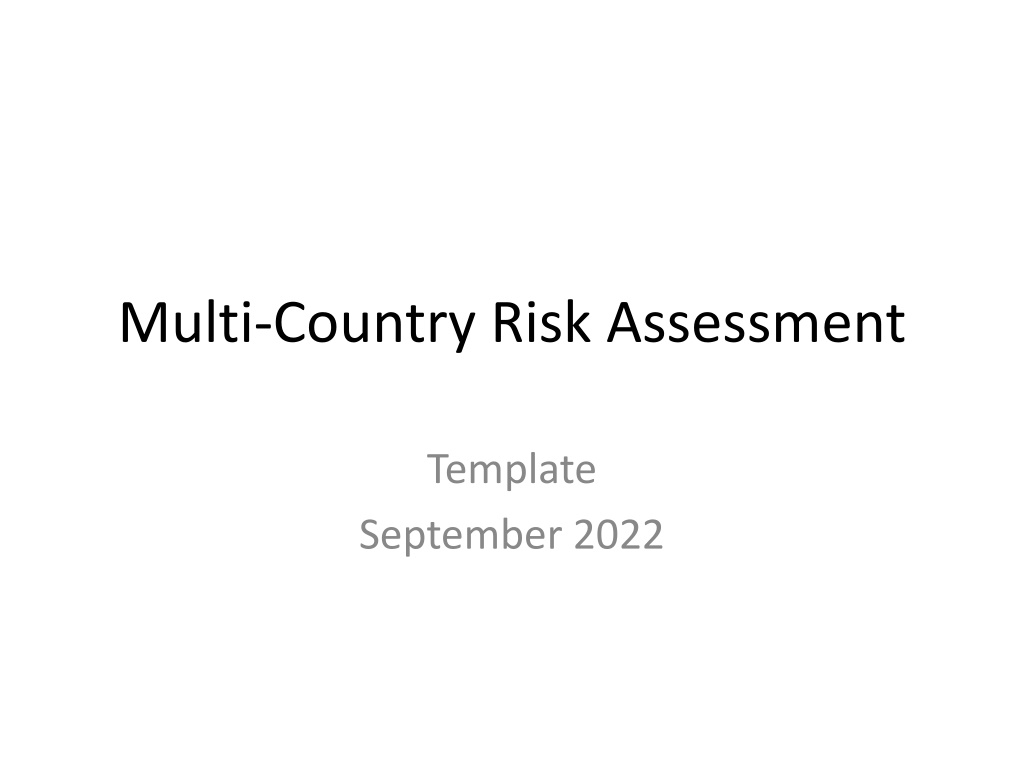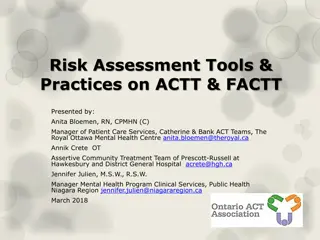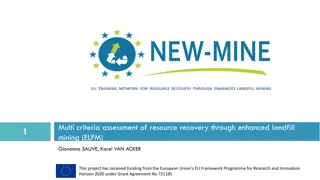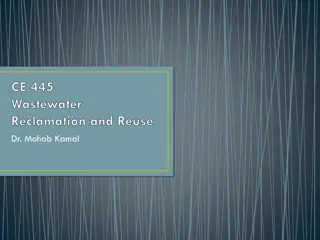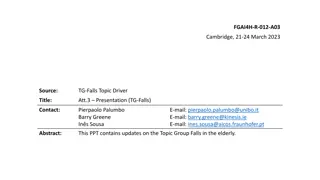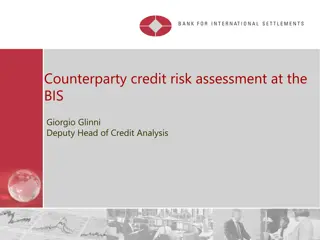Multi-Country Risk Assessment Summary - September 2022
This multi-country risk assessment template for September 2022 outlines key considerations related to decision-makers in the health sector, including political and technical authorities, potential messengers, and engagement strategies. It also covers details of isolates, epidemiological context, and mapping of new detections in the context of polio outbreak response planning.
Download Presentation

Please find below an Image/Link to download the presentation.
The content on the website is provided AS IS for your information and personal use only. It may not be sold, licensed, or shared on other websites without obtaining consent from the author. Download presentation by click this link. If you encounter any issues during the download, it is possible that the publisher has removed the file from their server.
E N D
Presentation Transcript
Multi-Country Risk Assessment Template September 2022
Landscape of decision makers and health sector priorities [To be completed by GPEI partners with country-level colleagues prior to engaging with country. The information should be updated as it becomes available] Who are the people within the MoH and/or government who will decide how and when the country responds to an outbreak? Are there national and subnational decision makers? Are there both political and technical decision makers? Have the decision makers been engaged in/briefed on the surveillance and modelling thus far? If so, how have they reacted to and /or engaged with the information and/or process? Have they provided a sense of how likely they are to move quickly to address the outbreak with a quality campaign. If they are reluctant to move forward have they articulated the reasons why? Who are the potential messengers to engage that are trusted by key decision makers? Do GPEI partners have colleagues already engaged with and trusted by decision makers who can be engaged? Are there donors, allies, CSOs, or other parties that can be engaged early on to communicate with decision makers? Is there demonstrated political will for immunization and polio eradication? What are the potential competing priorities such as conflict, malnutrition, drought, outbreaks of other diseases? What is the trend in immunization rates nationally and in the regions/districts of the outbreak? Has the country launched initiatives to increase immunization? Are they making vaccine co-pays on time. Are the outbreaks in areas where there are marginalized populations? 2
Details of Isolates Date of sample collection( ES) Type of virus (cVDPV or WPV) Source (AFP/ES) Date of onset (AFP) Emergence Group Epid Number Country/Province/District Nt changes EPI curve showing isolate by time and type 3
Epidemiologic context (1) Case/sample details Type of virus: [wild / VDPV / Sabin2] Virus serotype: [type 1, 2, 3] Source: [AFP / Environment / asymptomatic person] EPID no: Date of onset or date ES collected: Reporting date to CO / RO: Reporting date to WHO HQ: Location of onset of the case / envir. sample collection site: [if a person] Age and OPV dose status: Sequencing results: Nature of virus [nt difference from Sabin and closest matching sequence if available/applicable] + evidence of circulation Include commentary on the sequencing data and interpretation 4
Detailed polio case investigation [To be completed by Regional Office and Country Office once information is available] Key findings of field investigation [if known / if applicable] Missed AFP cases found through active case search in the community and health facilities: OPV/IPV coverage status assessed through rapid community survey: Number and lab testing results of samples taken from contacts (AFP) / community (ES): Health seeking behaviour of AFP case / missed opportunity to have reported the case earlier (if applicable): Travel links & population movement: Travel to other areas in-country: names of the districts Travel to other country: name of country and district, province 6
VDPV Detections Map of region/countries (and surrounding area if applicable) Indicate date range (past 6 months or past 12 months) Indicate locations of viruses detected from AFP cases and ES sample collection sites Optional emphasis on most recent detection(s) Note: a draft may be provided by the modeling team- If possible 7
Brief overview of most recent VDPV / WPV and response Areas covered during previous Outbreak or last 2-3 years in each country: Map 8
nOPV2 Preparedness Status (if applicable) Does the country meet EUL requirements for nOPV2 by the Readiness Verification Team (RVT)? If yes, date Checklist approved by RVT: If no, outstanding Checklist items and timeline for submission: 9
SIA Performance SIAs with mOPV2 or tOPV Date and number of SIAs conducted current year, incl. (LQAS/IM) results + type of vaccine used [indicate whether infected area was covered]. SIAs with bOPV Date and number of SIAs conducted current year, incl. (LQAS/IM) results + type of vaccine used [indicate whether infected area was covered]. SIAs with nOPV2 Date and number of SIAs conducted current year, incl. (LQAS/IM) results + type of vaccine used [indicate whether infected area was covered]. 10
Routine Immunization (IPV & OPV3) Coverage 2021 IPV 2020 IPV 2019 IPV Map Admin 1 (or Admin 2 if applicable) 2021 bOPV 2020 bOPV 2019 bOPV 11
Vaccination Status of Non Polio AFP Cases bOPV Doses Received by Children Aged 6-59 months Legend 0 doses 1-2 doses >2 doses Bar graph (0-100% on Y-axis) (countries on X-axis) Admin 1 (or Admin 2 if applicable) Note time window of included data 12
Conclusion/Inference on Vaccination/population immunity 13
AFP Surveillance Performance 2019 National Avg: ___ 2020 National Avg: ___ 2021 National Avg: ___ NP-AFP Rate Legend Map Admin 1 (or Admin 2 if applicable) Silent <1 1 to <2 2 to <3 3 2021 National Avg: ___ 2020 National Avg: ___ 2019 National Avg: ___ Stool Adequacy % 14
Environmental Surveillance Monthly environmental chart for at least last 12 months by collection site and by province Map of surveillance sites in each country Include labels of site names, country Optional indicate sites with enterovirus detection 50% in the past 6 months 15
Pending results of AFP cases and ES in the lab For AFP cases, indicate the dates of onset for cases not yet tested. For ES, include the date of collection for samples not yet tested. A table or map with the locations of pending results 16
Coordination of surveillance activities in between countries cross notification of AFP cases 17
Rationale for multi country WPV1 outbreak response Epidemiology Surveillance risk Immunity profile Population movement
Modeling Proposed Scope Save space for Notes/Caveats/Interpretation of model output Provided by modelling team Map of Immunity + detections Map of Suggested Scope Provided by modelling team Provided by modelling team Map of Relative Risk Provided by modelling team 21
Proposed course of action (1) [To be completed by Regional Office and Country Office once information is available] 1. Field investigation Laboratory investigation: Further case investigation & case finding: 2. Enhance ongoing surveillance measures (AFP, environmental): 3. Enhance /catch-up routine immunization (including bOPV and IPV): 22
Proposed course of action (2) [To be completed by Regional Office and Country Office once information is available] 4. Plans for vaccine response : OPV2 requested: [YES/NO] at this time Rationale (briefly) Target population, geographic area, age group Doses requested for each round Proposed dates SIA 1/2/3 (note, only 2 rounds indicated for nOPV2 responses) Type of OPV requested (mOPV2, nOPV2, tOPV, bOPV) and justification of the choice 5. Plans to inform neighbouring countries : [who, when, how, by whom] 23
Proposed OPV2 response (option 1) Country/Region preference Country Province District Target U5 Population A a,b,c, 1,2,3,4, Map of response scope B a,b,c, 1,2,3,4, C . Total Total doses requested:_______ Wastage factor used: _______ e.g., 1.25 for nOPV2 Any available vaccine in the country? Source of population data: _______ 24
Proposed OPV2 response (option 2) Country Province District Target U5 Population A a,b,c, 1,2,3,4, Map of response scope B a,b,c, 1,2,3,4, C . Total Total doses requested:_______ Wastage factor used: _______ e.g., 1.25 for nOPV2 Any available vaccine in the country? Source of population data: _______ 25
Map of multi-country response Map of multi-country response Option 1 Option 2 26
Summary Vaccine Needed and Proposed Dates Country Options Target U5 Population Total doses for 1 round (including wastage factor of XXX) Total doses for Round 1&2 Proposed dates for implementati on Country X Option 1 R1: R2: Country X Option 2 R1: R2: Total 27
Discussion, Conclusion and Recommendations 1. Assess risk Virological risk Contextual risk of further transmission Risk for international spread Box instructions: Risk Potential: Low / Medium / High 2. Assess need for OPV and evaluate vaccine request [if applicable] Type of vaccine (mOPV2, nOPV2, tOPV, bOPV) number of doses/rounds/extent/age 3. 4. 5. 6. Provide recommendation to WHO DG [if applicable] Provide recommendations to the country Outbreak grade- if available Instructions to UNICEF SD 29
Country context Population Population <15 and <5 in infected Admin 1 and Admin 2 In-country population movement (within country focusing on infected area) Internal movement of people, focus on infected area IDPs High risk population (in infected areas, especially)[if applicable] Characteristics (e.g., refugee, IDPs, inaccessible communities) Reasons for considering it has high risk International borders, neighbouring country(s) and population movement [if applicable] Proximity of affected area to borders Trade and travel patterns Refugee movement Security [Natural disaster, political instability, criminality/terrorism] (if applicable) Upcoming major events in country that may affect response (e.g. elections, meetings that may involved key MOH staff) [if applicable] 31
Country capacity National immunization service delivery ( as expressed by national EPI manager or higher authority) Immunization service system: [strong / moderate / weak (specify)] Human resources for management at all level: [adequate /inadequate /acute shortage, (specify)] Human resources for service delivery: [adequate /inadequate/acute shortage (specify)] Country s past experience in conducting polio SIA: Country s past experience in conducting other immunization campaign: GPEI-funded Human Resources in country[if applicable, use a table] Number, location/level of duty, Functions: Continued availability: till mm/yyyy GPEI HR Support needed 32
Immunization Date of tOPV-bOPV switch: [dd-mm-YYYY] Time after cessation of OPV2 [weeks/months/years elapsed between OPV2 cessation and detection of PV] Date of IPV introduction: [dd-mm-YYYY] Extent: [nationwide? If not, where?] 33
AFP surveillance Epidemiologic curves (previous 3 years) [bar graph, by week of onset] National level Infected Admin 1 level NP AFP rate and Stool adequacy (if possible, mapping at Admin 1 level) Calendar year / Previous 12 months Previous 6 months Environmental surveillance (if applicable) Monthly environmental chart for at least last 12 months by collection site and by province Conclusions / inferences: 34
Vaccination of migratory populations in between countries (nomads) 35
Vaccination of high risk populations like (IDPs, Refugees) 36
Vaccination at Border posts (international borders) 37
